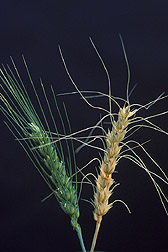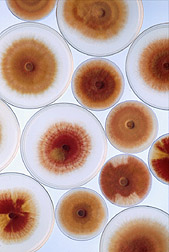This page has been archived and is being provided for reference purposes only. The page is no longer being updated, and therefore, links on the page may be invalid.
DNA Test Developed to Study, Combat Fusarium Head Blight in Wheat
By Jan SuszkiwMay 16, 2005
Identifying fungi that cause Fusarium head blight in cereal grains has become much easier, thanks to a new DNA-based test developed by Agricultural Research Service (ARS) scientists in Peoria, Ill.
At least 16 species of Fusarium can cause head blight, a disease that can reduce yields and contaminate cereals with toxins that can make grain unsafe for food or feed. From 1998 to 2000, these pathogens accounted for $2.7 billion in losses to U.S. agriculture.
The test was developed by molecular geneticists Todd Ward, Dave Starkey, Kerry O'Donnell and Brent Page at the ARS National Center for Agricultural Utilization Research in Peoria.
The test makes it possible for the first time to simultaneously identify all of the major head blight pathogens and predict their toxin profiles. Ward and O'Donnell envision using the test to understand the distribution of these pathogens worldwide, as well as to determine if individual pathogen species prefer certain crops or environments. This information is critical to the development of effective disease control strategies, including the production of cereal cultivars with broad resistance to Fusarium head blight pathogens.
Visual inspection is now used to spot these pathogens, but it cannot be used to identify which of the species is present in a field. To improve detection and epidemiology, the Peoria scientists devised a test that pinpoints nucleotide variations that genetically distinguish one head blight species from another.
The test relies on DNA "probes" designed by Ward and colleagues. When a probe matches the DNA in a head blight sample, the DNA is fluorescently labeled and detected using a special camera and a high-power laser, providing unambiguous identification of the head blight pathogen and its toxin potential. In addition, the test has been designed to identify new head blight species, according to Ward, who is in the Peoria center's Microbial Genomics and Bioprocessing Research Unit.
ARS is the U.S. Department of Agriculture's chief scientific research agency.


